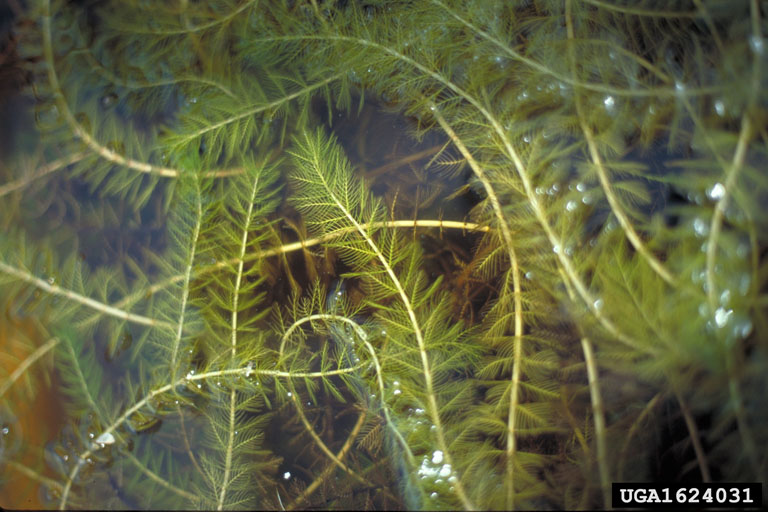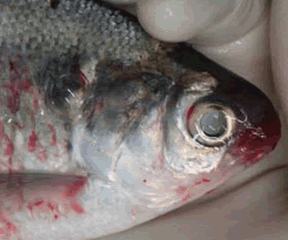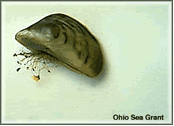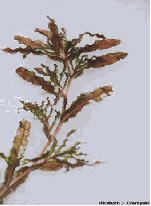Inquiries for boat ramp fees, pier rental, fishing licenses, issues with buoys, or water patrol should be directed to the Town of Randall who is responsible for these:
https://townofrandall.com
(262) 877-2165
Invasive Species
Invasive species, both aquatic and terrestrial, create many problems in Wisconsin. They change natural ecosystems, displace native species, reduce outdoor recreation opportunities and cost millions of dollars for control. Wisconsin has been working for several years to educate people about invasive species.
Powers Lake, like all inland lakes, continues to be threatened by Invasive (non-native) plants and animals that have a negative impact to the water quality, clarity and recreational use of the lake. As stewards of the lake, it is up to each of us to become more informed of the threats facing our waterways and to do our part to preserve this great natural resource.
Below are some of the most concerning Invasives that are either already in Powers Lake or threatening to impact us.
Eurasian Milfoil

Eurasian water milfoil is an aquatic plant native to Europe, Asia, and Northern Africa.
Eurasian milfoil first arrived in Wisconsin in the 1960s and spread quickly. By the 1990s, it was found in more than half of our Wisconsin counties. This plant upsets the delicate balance of a lake’s ecosystem by blocking out sunlight needed for native plants to grow. Poor water quality, lack of food for fish and waterfowl, interference with swimming and boating are all by-products of milfoil invasion.
- There are some things we can do, according to the Department of Natural Resources:
- Prevent fertilizers from reaching lakes and feeding milfoil colonies. You can maintain a natural shoreline, or plant a rain garden in areas that run off into the lakes and streams.
- Inspect and remove all aquatic plants from your boat, motor, trailer, and fishing equipment before you leave the lake.
- Hand pull or rake the plants, but be careful to remove fragments from the water and the shore. Plant native plants in their place to stabilize the bottom, build nurseries for small fish, attract waterfowl, and prevent new milfoil invasions. See http://dnr.wi.gov/topic/invasives/fact/eurasianwatermilfoil.html

VHS
VHS stands for Viral Hemorrhagic Septicemia. The intimidating name is appropriate since this virus is deadly to our Wisconsin fish population. Thankfully the virus cannot hurt humans, but it can kill 25 species of fish. A new law went into effect April 4, 2008, in order to prevent the spread of VHS.
The DNR is asking the public to take precautions similar to those used in stopping the spread of invasive species on all waters:
- Inspect your boat, trailer and equipment and remove visible aquatic plants, animals, and mud.
- Drain water from your boat, motor, bilge, live wells, and bait containers.
- Do not move live fish from one body of water to another.
- Dispose of leftover bait in the trash, not in the water or on land.
- Buy your minnows from Wisconsin bait dealers or catch your own and use it to fish the water you caught it from.
- Wash your boat and equipment with high pressure or hot water, or let it dry for five days.
Zebra Mussels

Zebra mussels were first found in Wisconsin waters of Lake Michigan in 1990. We believe the mussel larvae was introduced to our lakes from Eurasian originating ships. Powers Lake was infested in 2003, and as of April of 2008 the population of mussels in our lake reached 744,200. The way Zebra mussels feed impacts water clarity and depletes our waters’ food supply. Fish are especially adversely affected because a resulting higher light penetration makes it harder for larger fish to hunt their prey. Plant growth becomes very dense and disrupts the enjoyment of our swimmers, boaters, and fishermen. Zebra mussels are picky eaters, choosing only some types of algae for food. Therefore we may see an increase in the type of algae they eschew, such as blue-green algae.
Once zebra mussels become settled in a lake they thrive stubbornly, and very little can be done to control them. It is therefore essential to take all possible measures to prevent their introduction in the first place. Boaters can take specific precautions in protecting their motors from zebra mussels. (See above, relative to VHS)

Emerald Ash Borer
An emerald ash borer is a green colored beetle that attacks ash trees. A United States Department of Agriculture scientist in Michigan has confirmed the presence of emerald ash borer (EAB) in a newly planted ash tree in rural Kenosha County, several miles north of Silver Lake. This is the third documented discovery of the beetle in Wisconsin. According to Chris Williamson, a University of Wisconsin-Madison associate professor of entomology and an insect-control specialist for UW-Extension, "We have very good research data that shows the area of highest risk is within 10-12 miles of a known infestation." The area may be treated by injecting pesticides into the soil annually. "Outside of that area, I really don't think there's a need to treat," Williamson said.

Curly Leaf Pond Weed
Curly-leaf pondweed is an invasive aquatic perennial that is native to Eurasia, Africa, and Australia. It was accidentally introduced to United States waters in the mid-1880s by hobbyists who used it as an aquarium plant. The leaves are reddish-green, oblong, and about 3 inches long, with distinct wavy edges that are finely toothed. The stem of the plant is flat, reddish-brown and grows from 1 to 3 feet long. The plant usually drops to the lake bottom by early July.
Curly-leaf pondweed spreads through burr-like winter buds (turions), which are moved among waterways. These plants can also reproduce by seed, but this plays a relatively small role compared to the vegetative reproduction through turions. New plants form under the ice in winter, making curly-leaf pondweed one of the first nuisance aquatic plants to emerge in the spring.
It becomes invasive in some areas because of its tolerance for low light and low water temperatures. These tolerances allow it to get a head start on and out compete native plants in the spring. In mid-summer, when most aquatic plants are growing, curly-leaf pondweed plants are dying off. Plant die-offs may result in a critical loss of dissolved oxygen. Furthermore, the decaying plants can increase nutrients which contribute to algal blooms, as well as create unpleasant stinking messes on beaches. Curly-leaf pondweed forms surface mats that interfere with aquatic recreation.
Clean Boats, Clean Waters
With the growing concern over the spread of aquatic invasive species to Wisconsin’s inland lakes, many lake association members and other concerned citizens are looking for ways to get involved.
The Clean Boats, Clean Waters volunteer watercraft inspection program is an opportunity to take a front line defense against the spread of aquatic invasive species.
Through the Clean Boats, Clean Waters program, volunteers are trained to organize and conduct a boater education program in their community. Adults and youth teams educate boaters on how and where invasive species are most likely to hitch a ride into water bodies.
Volunteers perform boat and trailer checks for invasive species, distribute informational brochures and collect and report any new water body infestations.
